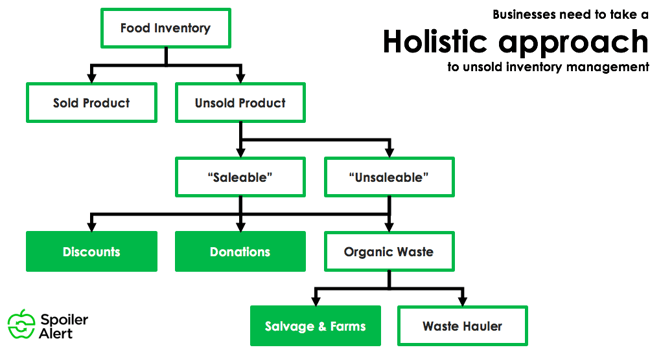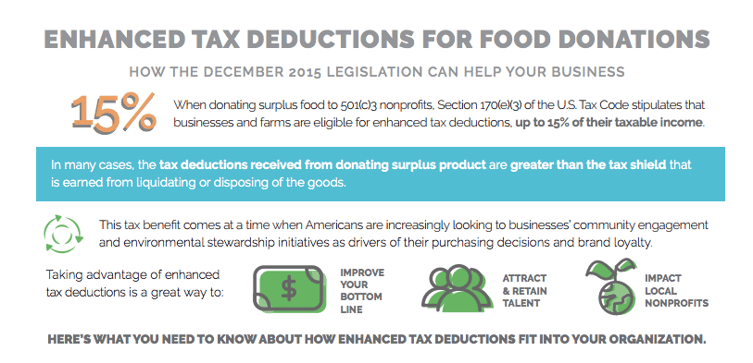
In our experience, four internal stakeholders play key roles when strategizing around unsold inventory management: Operations, Sustainability, Merchandising, and Finance. Before implementing an effective management program for unsold product, there are a number of questions that must be answered:
- What type of product is going unsold and why?
- What outlets are available and which will produce the greatest financial benefit?
- What operational improvements can be made to decrease the volume of unsold product?
It is impractical to think that a single department will have all the answers to these questions, nor will the same operating metrics and company objectives motivate their individual performance. These activities require multi-department collaboration to create the most effective outcome. For any food executive considering implementing or enhancing an unsold inventory management program, make sure a representative from each of these teams is included.

Businesses have a suite of options for managing unsold inventory, and identifying what's best for your business requires working together across departments.
Operations
Given that Operations teams are often responsible for making decisions on the services and technologies that track, transport, store, and remove products at a facility, it may be obvious that they should be the first stakeholder to engage. Operations employees can use existing inventory management systems to look into what product is going unsold, and depending on the level of software sophistication, perhaps offer a reason why. If data are lacking, Operations typically has a pulse on what information is necessary to make educated decisions and jumpstart improvements.
In addition, it is Operations that will be responsible for coordinating the handoff of product to an outlet - whether that be a closeout buyer, food recovery organization, or (as a last resort) a waste hauler. This requires logistics and communication and can create friction points that result in inefficiencies and distractions when partners are inconsistent or unreliable. Tapping Operations teams’ knowledge on how to streamline this process will be necessary.
Operations executives should note that their participation in programs can create real benefits for their team, including reductions in waste disposal fees and lowering of effective shrink rates. Once a successful program is established, standard operating procedures (SOPs) can be developed and implemented across a portfolio of facilities to improve the efficiency and effectiveness of managing unsold product. This, in turn, reduces the time required for employee training in instances of turnover, thus improving the Human Resources function.
Sustainability
Whether your company refers to it as Corporate Social Responsibility, Community Relations, or Environmental Health and Safety, food loss and waste (FLW) reduction has become a major focus of Sustainability teams at food companies, with top food service providers, major food company executives, and leading food distributors all committing to action. Therefore, if it wasn’t the idea of the sustainability team member to focus on unsold inventory management, there is no doubt that they should be included in the strategy.
Sustainability roles will be the best internal champions and cheerleaders for the program. These are the folks that can educate other stakeholders on both the financial benefits (like reducing costs associated with wasted food) and nonfinancial benefits (like enhancing employee engagement or strengthening community through food donation) that can stem from effective management of unsold product. Sustainability teams can also analyze and develop impact metrics from the program to include in sales and marketing collateral. Working together, sales and sustainability teams can promote the program in a manner that differentiates brand and builds thought leadership around an important environmental and social issue.
Merchandising
Merchandising, or teams responsible for product procurement, are the third key internal stakeholder to bring into the conversation. Up to this point, we have discussed a lot about managing existing unsold inventory, and figuring out strategies to capture the most value from this product and create benefits across the company. But what about preventing inventory from going unsold in the first place? This is where Merchandising teams can come in, and it is often their performance that is at stake when shrink totals climb.
As companies start to understand the root causes for why product goes unsold, Merchandising can begin to modify purchasing strategies to address issues within their control. For example, if a company is consistently left with unsold holiday-themed inventory, Merchandising can use this information when determining how much holiday-themed product to purchase the following year. How effective this strategy will be depends on how comprehensive the data is to inform better purchasing decisions - adopting technology-enabled inventory management systems can help improve data collection.
Finance
The last, but certainly not least, internal stakeholder to tap is Finance. Product that is left unsold for whatever reason represents a cost that is hard to fully recover. Some outlets for it, such as discounted sales or liquidation, can unlock earned revenue, whereas other outlets, such as disposal, add more operating costs. Since Finance teams are responsible for identifying opportunities to boost revenues and improve the bottom line, it is clear that they should be involved in determining which outlets create the most financial benefit at any given time.
This will depend on factors like discounted sale price point or whether the company takes advantage of enhanced tax deductions from donation. For this reason, it will be important to bring finance representatives in early to set up protocols on maximizing the value that can be captured. Even modest reductions in unsold inventory that ends up as trash can represent major boosts to a large food business’ bottom line, thus Finance has a clear incentive to participate.

Download this infographic for information on claiming enhanced tax deductions for food donation.
All about alignment
Getting all of these internal stakeholders into the same room is great, but it is only the first step. Once at the table, it is essential to align individuals to ensure:
- Roles are clearly defined;
- Programs are resourced efficiently;
- Leadership teams are bought-in; and
- Standard operating procedures can be put in place.
Spoiler Alert prioritizes stakeholder alignment as the first step when working with clients. If you are considering an unsold inventory management strategy, schedule a meeting with our Director of Business Development to find out how our solution can maximize the benefits of your program.
.png?width=250&name=SpoilerAlert_WhiteLogo_LeftStacked%20(7).png)
